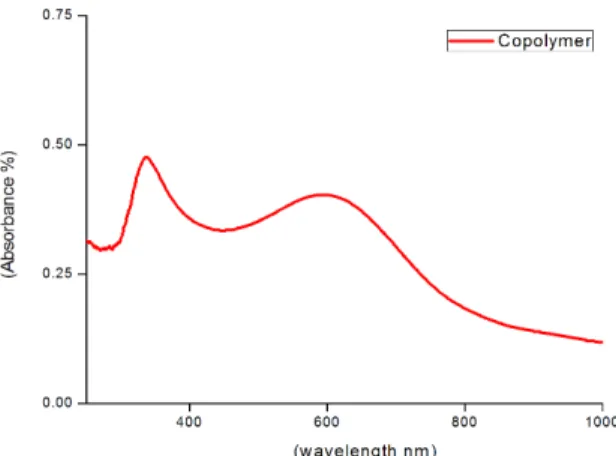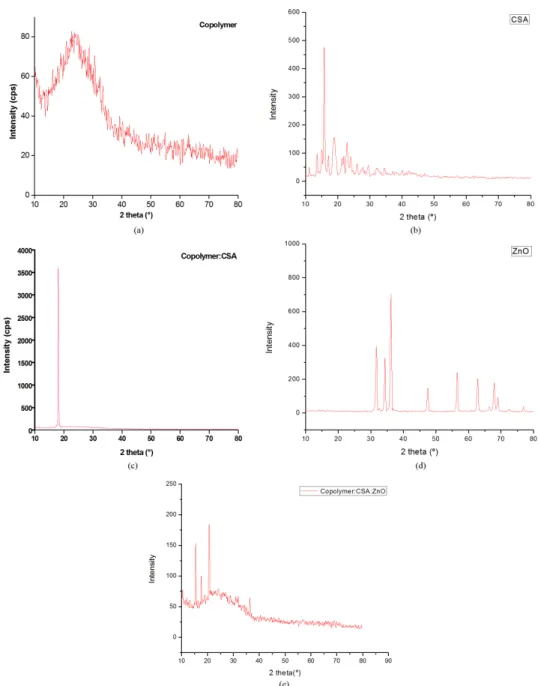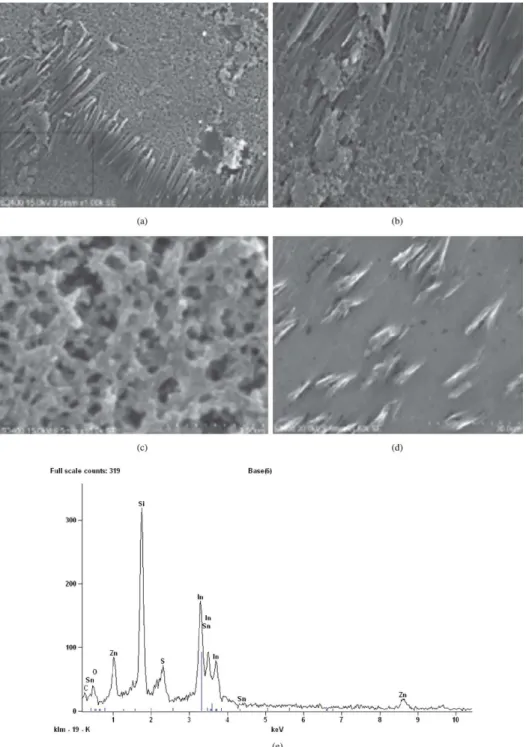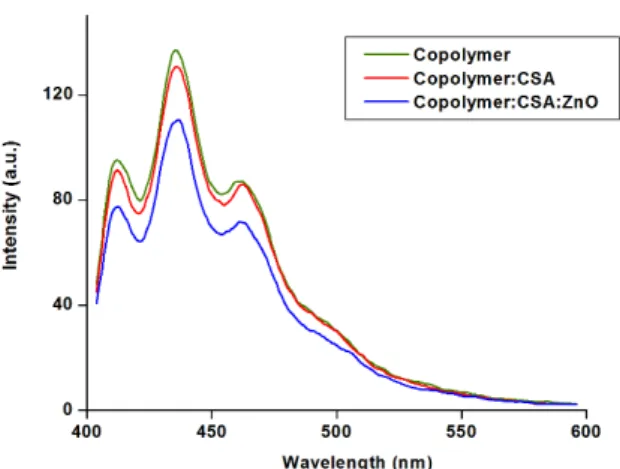*e-mail: vijayps6@yahoo.co.in
1. Introduction
Polyaniline (PANI) and its derivatives have been extensively studied in the last decade with improved processing and intrinsic electrical properties. They have received great attention owing to its ease of synthesis, good stability in the presence of oxygen and possessing electrochemical properties of unique conducting mechanism. This polymer can be obtained by electrochemical and chemical oxidative polymerization of aniline in aqueous solutions. Poly (o-toluidine) is a PANI derivative which contains the –CH3 group in the ortho position of the aromatic ring of the aniline monomer. Among the ring-substituted PANI derivatives, Poly (o-toluidine) has been most widely studied one. With regard to polyaniline based copolymers, a pioneering work has been reported about aniline copolymerization with o-toluidine and aminoacetophenone possessing conductivity property of broad range1-4. The copolymer was found to be soluble in common organic solvents like CHCl3, THF, DMF, NMP and DMSO5. The thermal stability of the copolymer was studied and found to vary irregularly with AN-OT molar ratio6-8.
The copolymer shows new morphology with higher thermal stability and better solubility than its homopolymers. Potentiodynamic polarization and electrochemical impedance spectroscopy have been employed to study the corrosion inhibition effects of this copolymer on carbon steel9. Recently it has been reported that the metal composite of poly (aniline-co-o-toluidine)-BaFe12O19 composite exhibited a ferro
magnetic behavior10. Juliet et al reported the characterization of copolymerization of aniline-co-o/m-toluidine and V2O5 nanocomposites11. Optical band gap of PANI-co-POT
thin ilm are found to be lower than that of POT ilms and shows a rectifying behavior12 and a spin coated thin ilm of polyaniline doped with camphorsulfonic acid (CSA) has been found to possess novel microstructure surface for NH3 detection at room temperature with better response13. Polyaniline has been used as an effective candidate as hole transporting layer in organic solar cells instead of PEDOT:PSS[14,15]. Polyaniline with amorphous silicon in heterojunction solar cells has been reported and found to have higher open circuit voltages in the solar cells16. Among metal oxide nanoparticles, zinc oxide nanoparticles possess their own importance due to their vast area of applications as gas sensor, chemical sensor, optical, electrical devices and solar cells17-21. ZnO nanoparticles are becoming promising semiconductor oxides when applied as an electron transport material22. Zinc oxide nanoparticles has been synthesized and used in dye sensitized solar cells23. Addition of ZnO nanoparticles into the copolymer chain will improve their compatibility and increases the thermal stability of the copolymer24. Polyaniline-ZnO nanocomposite
thin ilm has been fabricated on glass substrates by vacuum deposition technique25. It has been reported that polymers doped with organic acids lead to possess high conductivity because organic solvents such as m-cresol and other substituted phenols act as secondary dopants26-33.
CSA Doped Poly(aniline-co-o-toluidine) and Dispersed Zinc Oxide Nanoparticles:
a Promising Material for Photovoltaics
Arunachalam Mahudeswarana, Devarajan Manoharanb, Joseph Chandrasekaranb,
Janakiraman Vivekanandana, Pachanoor Subbaian Vijayananda*
aDepartment of Physical Sciences, Bannari Amman Institute of Technology, 638401, Sathyamangalam, Tamil Nadu, India
bMaterials Science Laboratory, Department of Physics, Sri Ramakrishna Mission Vidyalaya College of Arts and Science, 641020, Coimbatore, Tamil Nadu, India
Received: June 10, 2014; Revised: March 25, 2015
Copolymerization of aniline and o-toluidine is achieved by chemical oxidative polymerization with equal molar ratio of monomers in the presence of hydrochloric acid and ammonium persulphate as an oxidant. The copolymer found to be more soluble in polar solvents such as NMP, DMF and DMSO. FTIR spectroscopy conirms the copolymer chemical structure. UV spectroscopy shows π to π* transition and excitonic transition of the copolymer ilm. The copolymer is doped with camphorsulfonic acid (CSA) in m-cresol and then zinc oxide nanoparticles are dispersed into the copolymer and spin coated on to a glass plate. The scanning electron microscope image shows the morphology of the copolymer matrix. X-ray Diffraction shows the characteristic peaks of CSA and zinc oxide. EDAX analysis conirms the presence of CSA and zinc oxide. The dispersion of zinc oxide nanoparticles show quenching property of photoluminescence indicating that the copolymer can be used in the opto-electronics.
The aim of the present research work is to synthesize, characterize and study the electronic properties of poly(aniline-co-o-toluidine) copolymer doped with CSA and dispersion of ZnO nanoparticles. The synthesized copolymer composites are spin coated to form a thin ilm using spin coating technique. The ilm is then subjected to various characterization techniques such as UV-Vis, FTIR, PL, XRD, SEM and EDAX.
2. Material and Methods
The chemicals used for the synthesis are of AR grade. Aniline monomer and ammonium persulphate (APS) were purchased from Merck and o-toluidine from Lobachime. Camphorsulfonic acid and zinc oxide nanoparticles were purchased from Sigma Aldrich. 0.1 M aniline (0.5 ml in 50 ml of 1 M HCl solution) and 0.1 M o-toluidine(0.5 ml in 50 ml of 1 M HCl solution) monomers were added in a 250 ml round bottom lask. 0.2 M ammonium persulfate solution (4.56 gm of APS dissolved in 100 ml of 1 M HCl solution in separation funnel and it was added drop wise to the monomer mixture. As soon as the oxidant was added, the polymerization reaction began in the 1 M of hydrochloric acid medium. The reaction mixture was allowed to stir continuously for four hours. The temperature of the reaction mixture was maintained between 0°C to 5°C. The obtained copolymer was washed and iltered. A dark green precipitate is obtained and dried in vacuum at 60°C. The obtained green colored emeraldine salt was an HCl doped polymer. The copolymer was undoped by mixing with 50% of aqueous ammonia solution (50 ml of ammonia added in 50 ml of distilled water) and allowed to stir continuously for four hours. A dark bluish color was obtained and dried. The emeraldine base of the copolymer was doped CSA with a ratio of 1:5 in 1 ml of m-cresol in 5 ml vial which acts as a medium and secondary dopant. The solution was stirred for 5 days to get homogeneous solution. Finally the resultant solution was spin coated at 750 rpm for 20 secs. Zinc oxide nanopowder (2 mg) was dispersed into the CSA doped copolymer and then it was spin coated on a glass plate to form a thin ilm. The copolymer, CSA and ZnO in the composite are in the ratio of 1:5:1.
2.1. Characterization
The synthesized copolymer was characterized with FT-IR analysis which was recorded using Perkin Elmer FTIR Spectrometer as with KBr pellets. The samples were coated into thin ilm by using Programmable spin coater SCU 2008C. The thin ilm was characterized by UV-Vis spectroscopy using JASCO-V570 spectrophotometer. X-ray diffraction patterns were taken using Philips model TW 1710 diffractometer with Cu Kα radiation of 1.5417 angstrom. The SEM and EDAX were taken using Philips XL 30. Photoluminescence spectra were recorded using FT 600 spectrolurometer.
3. Results and Discussion
3.1. FTIR analysis
Figure 1 represents the FT-IR spectrum of the synthesized copolymer. The characteristic peak about 3350 cm–1 corresponds
to the N-H stretching of the primary amine and conirms
the amino group. The peak at 2920 cm–1 attributes to the C-H stretching vibration of methyl group. The absorption peak at 1590 cm–1 is assigned to the quinoid ring stretching. The peak observed at 1494.20 cm–1 corresponds to the presence of C=C stretching vibration in benzenoid ring. The sharp peak at 809.39 cm–1 attributes the para-coupled phenyl ring in the copolymer. The absorption band around 1145 cm–1 conirms the charge delocalization. The peak at 1297.78 cm–1 corresponds to the C-N stretching vibrations of the aromatic primary amine5.
3.2. UV-Visible analysis
The UV-Vis spectrum of the copolymer from NMP is shown in the Figure 2. There are two absorption peaks observed in the spectrum at 337 nm and 603 nm respectively. The peak at 337 nm corresponds to the π – π* transition. The peak at 603 nm corresponds to excitonic transition between highest occupied molecular orbital of the benzenoid ring and lowest unoccupied molecular orbital in quinoid ring or n – π* transition of the copolymer34.
3.3. XRD analysis
Figure 3a shows the X-ray diffraction of the copolymer. It shows the broad amorphous diffraction peak due to the presence of benzoid and quinoid rings of copolymer. Figures 3b, c show X-ray diffraction of the pure CSA and copolymer doped with CSA thin ilm respectively. Since the
Figure 1. FTIR spectrum of poly (aniline-co-o-toludine) copolymer.
ratio of CSA is much higher than copolymer in the composites, the solvent vaporizes and excessive CSA crystallizes after spin coating and thus showing a high intensity peak at the 2θ value of 18.08°35. This may be due to growth and formation of expanded chains of CSA doped copolymer and aligned orderly to one direction as clearly seen in the SEM image36. Macdiarmid et al has reported about XRD
pattern of crystallized CSA doped polyaniline ilms and also emphasized the effect of secondary dopant m-cresol on the expanded coil like conformation37. Figure 3e shows the XRD pattern of copolymer with CSA doped and dispersed with ZnO nanoparticles. The three peaks at 15.39°, 17.56° and 20.59° indicate the crystalline camphorsulfonic acid and the values are conirmed with JCPDS data no. 12-0907. Similar
new peaks were observed with the same 2θ value of 15.44° and 17.61° in PPy-ZnO-CSA thin ilm38. After dispersing the zinc oxide nanoparticles, the ordered structure is disturbed and a hexagonal crystal structure is obtained giving rise to new peaks, which may reduce the electrostatic interaction between the copolymer and CSA. The molecular interaction between the m-cresol phenyl ring and CSA may also decrease and thus reducing the peak intensity. The XRD pattern of pure zinc oxide nanoparticles are shown in the Figure 3d. The high intensity peak for ZnO nanoparticles is at 36° and the characteristic peak at 36.32° in Figure 3e indicating the presence of ZnO nanoparticles in the polymer matrix, which possesses (101) plane and it matches with JCPDS data in no.79-0208
Figure 3. (a) XRD pattern of Copolymer ilm; (b) XRD pattern of pure CSA; (c) XRD pattern of CSA doped Copolymer; (d) XRD pattern
Figure 4. (a) SEM image Thin Film of CSA doped copolymer; (b) SEM image Enlarged image from Figure 4a; (c) SEM image thin ilm
of CSA doped copolymer; (d) SEM image ZnO dispersed CSA doped copolymer; (e) EDAX spectrum of CSA doped copolymer with ZnO nanoparticles thin ilm.
3.4. SEM analysis
Figures 4a, b and c show the scanning electron microscope images of the copolymer doped with CSA at different magniication. Figure 4a shows highly grown hexagonal structure in the morphology of the ilm. All the crystals are aligned in the same direction and Figure 4b is the enlarged image shows growing crystals in the same direction. This structure may be due to the electrostatic interaction between
Figure 4c shows the porous morphology of copolymer matrix and appears to be composed of mostly ibrous structure. Figure 4d shows the SEM image of the copolymer doped with CSA and dispersion of zinc oxide nanoparticles. It shows that the rods like CSA are arranged in the same direction and the corresponding EDAX result is also shown in Figure 4e. The dispersed ZnO nanoparticles occupy in the porous copolymer ilm and therefore surface becomes smooth and hexagonal crystalline rods of CSA are uniformly distributed all over the polymer ilm. The EDAX conirms the presence of the carbon, sulphur, oxygen and zinc.
3.5. Photoluminescence studies
Figure 5 shows the photoluminescence spectra of the i) copolymer, ii) CSA doped copolymer and iii). ZnO nanoparticles dispersed CSA doped copolymer. The photoluminescence spectra of all the samples were taken with an excitonic wavelength of 380 nm. All the spectra show a common peak at 412 nm, 436 nm, 461 nm and a shoulder peak around 500 nm. The high intensity peak at 436 nm is due to the polaronic band of the copolymer. When the zinc oxide nanoparticles are dispersed, there is quenching in the PL spectrum showing the charge transfer between the copolymer and nanoparticles. The PL quenching is an evidence for exciton dissociation. As the photo excitons are dissociated, the probability for recombination will be less due to the ultra fast electron
transfer reaction from donor to acceptor40. The quenching in emission spectrum is more in the case of ZnO nanoparticles dispersed polymer because of larger surface area leading to a higher possibility of charge transfer at the copolymer/ZnO interface. Here ZnO semiconducting nanoparticles act as an acceptor material. Similar quenching of PL spectrum has been reported when ZnO nanoparticles are added to MEH-PPV41, MDMO-PPV42,43 and P3HT44 ilms. This interesting quenching action in PL spectrum suggests that this copolymer composite material can be used for photovoltaic devices.
4. Conclusions
Poly (aniline-co-o-toluidine) copolymer has been successfully synthesized through chemical oxidation polymerization method. CSA doped Poly (aniline-co-o-toluidine) copolymer and dispersion of zinc oxide nanoparticles thin ilm has been successfully coated on glass substrates by spin coating technique. The synthesized copolymer is characterized by FTIR, UV, and XRD analysis. SEM study reveals the sponge like porous morphology of the copolymer composite.
π – π* and n – π* transition of benzonoid and quinoid groups of the copolymer are conirmed from the UV spectral studies. The FT-IR analysis conirms the chemical structure of copolymer. From the XRD pattern we can observe the crystalline nature of the CSA doped copolymer nanocomposties. Since the Poly (aniline-co-o-toluidine) copolymer is found to be highly soluble in NMP, it paves the way to have more application perspectives. The quenching in the photoluminescence spectrum indicates the charge transfer between the copolymer and the zinc oxide nanoparticles. These results strongly reveal that they are ideally suited for the manufacture of optoelectronic devices and could be used for photovoltaic application. Further extended research work in this direction will be highly useful for solar cell fabrication technology.
Acknowledgements
Authors acknowledge the Management of Bannari Amman Institute of Technology and Sri Ramakrishna Mission Vidyalaya College of Arts and Science for their immense support.
Figure 5. Photoluminescence Spectra.
References
1. Wei Y, Focke WW, Wnek GE, Ray A and MacDiarmid AG. Synthesis and electrochemistry of alkyl ring-substituted polyanilines. Journal of Physical Chemistry. 1989; 93(1):495-499. http://dx.doi.org/10.1021/j100338a095.
2. Wei Y, Hariharan R and Patel SA. Chemical and electrochemical copolymerization of aniline with alkyl ring-substituted anilines. Macromolecules. 1990; 23(3):758-764. http://dx.doi.org/10.1021/ ma00205a011.
3. Anbarasan R, Vasudevan T and Gopalan A. Chemical grafting of poly(aniline) and poly(o-toluidine) onto PET fibre — a comparative study. European Polymer Journal. 2000; 36(8):1725-1733. http://dx.doi.org/10.1016/S0014-3057(99)00242-6.
4. Ravi Kumar G, Vivekanandan J, Mahudeswaran A and Vijayanand PS. Synthesis and characterization of novel
poly(aniline-co-m-aminoacetophenone) copolymer nanocomposites using dodecylbenzene sulfonic aicd as a soft template. Iranian Polymer Journal. 2013; 22(12):923-929. http://dx.doi.org/10.1007/ s13726-013-0191-x.
5. Kumar D. Synthesis and characterization of poly(aniline-co-o-toluidine) copolymer. Synthetic Metals. 2000; 114(3):369-372. http://dx.doi.org/10.1016/S0379-6779(00)00270-8.
6. Huang M-R, Li X-G, Yang Y-L, Wang X-S and Yan D. Oxidative copolymers of aniline with o-toluidine: their structure and thermal properties. Journal of Applied Polymer Science. 2001; 81(8):1838-1847. http://dx.doi.org/10.1002/app.1617.
8. Shreepathi S and Holze R. Investigations of chemically synthesized poly(aniline-co-o-toluidine)s doped with dodecylbenzenesulfonic acid. Journal of Applied Polymer Science. 2009; 113(2):700-708. http://dx.doi.org/10.1002/app.30104.
9. Benchikh A, Aitout R, Makhlouf L, Benhaddad L and Saidani B. Soluble conducting poly(aniline-co-orthotoluidine) copolymer as corrosion inhibitor for carbon steel in 3% NaCl solution. Desalination. 2009; 249(2):466-474. http://dx.doi.org/10.1016/j. desal.2008.10.024.
10. Jiang J, Ai LH and Liu L-Y. Poly(aniline-co-o-toluidine)/ BaFe12O19composite: preparation and characterization. Materials Letters. 2010; 64(7):888-890. http://dx.doi.org/10.1016/j. matlet.2010.01.043.
11. Jeyakumari JL, Yelilarasi A, Sundaresan B, Dhanalakshmi V and Anbarasan R. Chemical synthesis of poly(aniline-co-o/m-toluidine)/V2O5nanocomposites and their characterizations. Synthetic Metals. 2010; 160(23-24):2605-2612. http://dx.doi. org/10.1016/j.synthmet.2010.10.011.
12. Elmansouri A, Hadik N, Outzourhit A, Lachkar A, Abouelaoualim A, Achour ME, et al. Schottky diodes and thin films based on copolymer: poly(aniline-co-toluidine). Active and Passive Electronic Components.2009; 2009:378086.
13. Verma D and Dutta V. Novel microstructure in spin coated polyaniline thin films. Journal of Physics: Condensed Matter. 2007; 19(18):186212.
14. Han YK, Chang MY, Ho KS, Hsieh TH, Tsai JL and Huang PC. Electrochemically deposited nano polyaniline films as hole transporting layers in organic solar cells. Solar Energy Materials and Solar Cells. 2014; 128:198-203. http://dx.doi. org/10.1016/j.solmat.2014.04.031.
15. Bejbouji H, Vignau L, Miane JL, Dang MT, Oualim EM, Harmouchi M, et al. Polyaniline as a hole injection layer on organic photovoltaic cells. Solar Energy Materials and Solar Cells. 2010; 94(2):176-181. http://dx.doi.org/10.1016/j. solmat.2009.08.018.
16. Wang W, Schiff E and Wang Q.Amorphous silicon/polyaniline heterojunction solar cells: fermi levels and open circuit voltages. Journal of Non-Crystalline Solids.2008; 354(19-25):2862-2865
17. Baxter JB and Aydil ES, Nanowire-based dye-sensitized solar cells. Applied Physics Letters.2005;86:53114.
18. Huang MH, Mao S, Feick H, Yan HQ, Wu Y, Kind H, et al. Room temperature ultraviolet nanowire nanolasers. Science. 2001; 292:1897-1899.
19. Song J, Zhou J and Wang ZL. Piezoelectric and semiconducting coupled power generating process of a single ZnO belt/wire. A technology for harvesting electricity from the environment. Nano Letters. 2006; 6(8):1656-1662. http://dx.doi.org/10.1021/ nl060820v. PMid:16895352
20. Wang ZL. Functional oxide nanobelts: materials, properties and potential applications in nanosystems and biotechnology. Annual Review of Physical Chemistry. 2004; 55(1):159-196. http://dx.doi.org/10.1146/annurev.physchem.55.091602.094416. PMid:15117251
21. Sawai J, Igarashi H, Hashimoto A, Kokugan T and Shimizu M. Effect of ceramic powder slurry on spores of bacillus subtilis. Journal of Chemical Engineering of Japan. 1995; 28(5):556-561. http://dx.doi.org/10.1252/jcej.28.556.
22. Gonzalez-Valls I and Lira-CantuM. Vertically aligned nanostructures of ZnO for excitonic solar cells : a review energy.Environmental Sciences. 2009; 2:19-34.
23. SulimanAE, Tang Y and Xu L. Preparation of ZnO nanoparticles and nanosheets and their application to dye-sensitized solar cells.
Solar Energy Materials and Solar Cells. 2007; 91(18):1658-1662. http://dx.doi.org/10.1016/j.solmat.2007.05.014.
24. Tang E, Cheng G and Ma X. Preparation of nano-ZnO/PMMA composite particles via grafting of the copolymer onto the surface of zinc oxide nanoparticles. Powder Technology. 2006; 161(3):209-214. http://dx.doi.org/10.1016/j.powtec.2005.10.007.
25. Kaushik A, Kumar J, Tiwari MK, Khan R, Malhotra BD, Gupta V, et al. Fabrication and characterization of polyaniline-znO hybrid nanocomposite thin films. Journal of Nanoscience and Nanotechnology. 2008; 8(4):1757-1761. http://dx.doi. org/10.1166/jnn.2008.006. PMid:18572575
26. Wang YZ, Joo J, Hsu CH and Epstein AJ. Charge transport of camphor sulfonic acid-doped polyaniline and poly(o-toluidine) fibers: role of processing. Synthetic Metals. 1995; 68(3):207-211. http://dx.doi.org/10.1016/0379-6779(94)02304-H.
27. Matveeva ES, Parkhutik VP, Calleja RD and Hernandez-Fuentes I. Variation of a.c. electrical properties of emeraldine base of polyaniline during its drying from suspension in m-cresol. Synthetic Metals. 1996; 79(2):159-163. http://dx.doi. org/10.1016/0379-6779(96)80185-8.
28. Silva JEP, Torresi SIC, Temperini MLA, Goncalves D and Oliveira ON Jr. A comparative study of m-cresol treated polyaniline and Langmuir Blodgett films. Synthetic Metals. 1999; 101(1-3):691. http://dx.doi.org/10.1016/S0379-6779(98)00801-7.
29. Cocher M, Corraze B, Quillard S, Buisson JP, Lefrant S and Louarn G. Electronic and vibrational changes induced by different acidic vapors in polyaniline. Synthetic Metals. 1997; 84(1-3):757-758. http://dx.doi.org/10.1016/S0379-6779(96)04132-X. 30. González I, Vecino M, Munoz E, Santamarıa A and Pomposo
A. Electrically conducting gels formed from Polyaniline/ Ethylcellulose/m-Cresol ternary solutions. Macromolecular Chemistry. 2004; 205(10):1379-1384. http://dx.doi.org/10.1002/ macp.200400109.
31. Lee K, Cho S, Park SH, Heeger AJ, Lee CW and Lee SH. Metallic transport in polyaniline. Nature. 2006; 441(7089):65-68. http://dx.doi.org/10.1038/nature04705. PMid:16672965
32. Garai A and Nandi AK. Rheology of (±)-camphor-10-sulfonic acid doped polyaniline-m-cresol conducting gel nanocomposites. Journal of Polymer Science. Part B, Polymer Physics. 2008; 46(1):28-40. http://dx.doi.org/10.1002/polb.21339.
33. Lee K-H, Park BJ, Song DH, Chin I-J and Choi HJ. The role of acidic m-cresol in polyaniline doped by camphorsulfonic acid. Polymer. 2009; 50(18):4372-4377. http://dx.doi.org/10.1016/j. polymer.2009.07.009.
34. Xin LY, Zhang X-G, Zhang G-Q and Shen C-M. Synthesis and characterization of aniline and o-toluidine conducting copolymer microtubes with the template-synthesis method. Journal of Applied Polymer Science. 2005; 96(5): 1539-1543. http://dx.doi.org/10.1002/app.21548.
35. He C, Tan Y and Li Y. Conducting polyaniline nanofiber networks prepared by the doping induction of camphor sulfonic acid. Journal of Applied Polymer Science. 2003; 87(9):1537-1540. http://dx.doi.org/10.1002/app.11599.
36. Yan H, OhtaT and Toshima N. Stretched Polyaniline films doped by (±)-10- camphorsulfonic acid: Anisotropy and improvement of thermoelectric properties. Macromolecular Materials and Engineering. 2001; 286(3):139-142. http:// dx.doi.org/10.1002/1439-2054(20010301)286:3<139::AID-MAME139>3.0.CO;2-F.
38 Chougle MA, Khuspe GD, Sen S and Patil VB. Polypyrrole-ZnO nanohybrids: effect of CSA doping on structure, morphology and optoelectronic properties. Applied Nanoscience. 2013; 3(5):423-429.
39. Ikkala OT, Pietila L-O, Ahjopalo L, Osterholm H and Passiniemi PJ. On the molecular recognition and associations between electrically conducting polyaniline and solvents. The Journal of Chemical Physics. 1995; 103(22):9855-9863. http://dx.doi. org/10.1063/1.469952.
40. Middya S, Layek A, Dey A and Ray PP. Morphological impact of ZnO nanoparticle on MEHPPV: ZnO based hybrid solar cell. Journal of Materials Science Materials in Electronics. 2013; 24(11):4621-4629. http://dx.doi.org/10.1007/s10854-013-1453-2.
41. Ton-That C, Phillips MR and Nguyen T-P. Blue shift in the luminescence spectra of MEH-PPV films containing ZnO
nanoparticles. Journal of Luminescence. 2008; 128(12):2031-2034. http://dx.doi.org/10.1016/j.jlumin.2008.07.004.
42. Beek WJ, Wienk MM, KemerinkM, Yang X and Janssen RAJ. Hybrid zinc oxide conjugated polymer bulk heterojunction solar cells. The Journal of Physical Chemistry B. 2005; 109(19):9505-9516. http://dx.doi.org/10.1021/jp050745x. PMid:16852143
43. Beek WJE, Slooff LH, Wienk MM, Kroon JM and Janssen RAJ. Hybrid solar cells using a Zinc oxide precursor and a conjugated polymer. Advanced Functional Materials. 2005; 15(10):1703-1707. http://dx.doi.org/10.1002/adfm.200500201.



